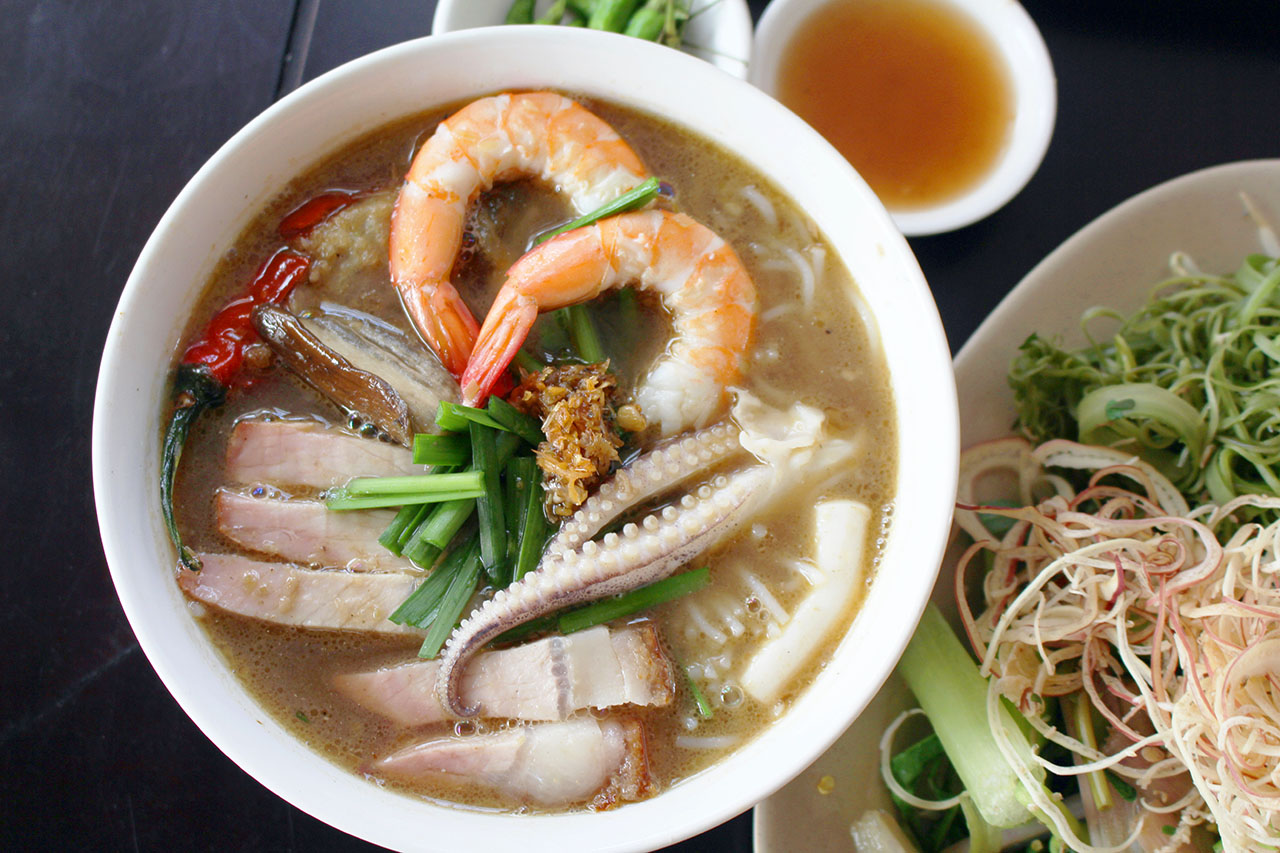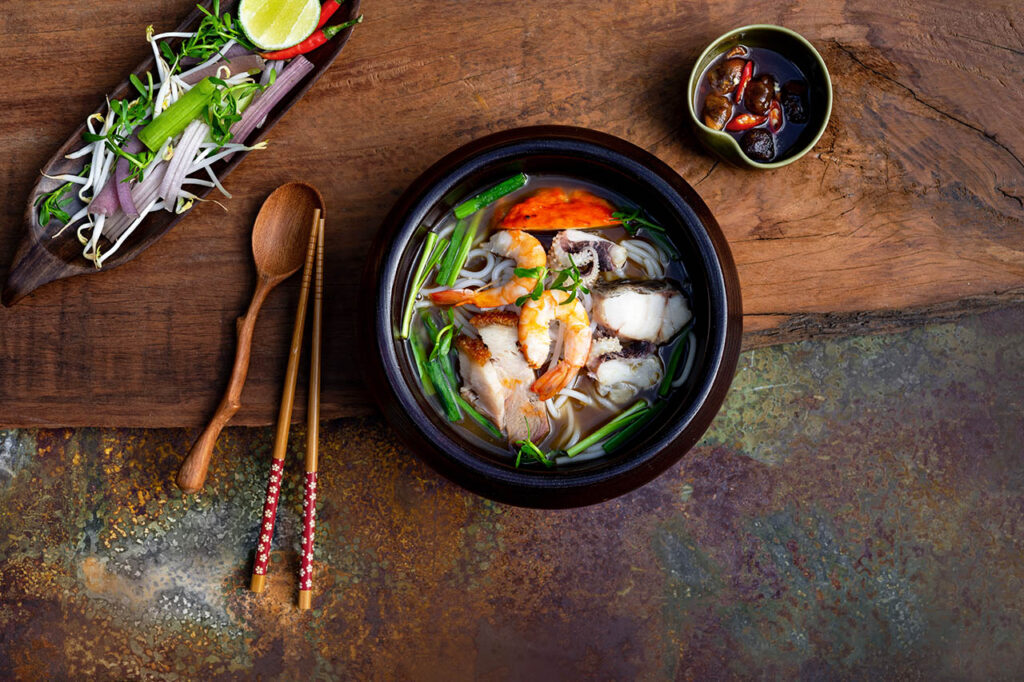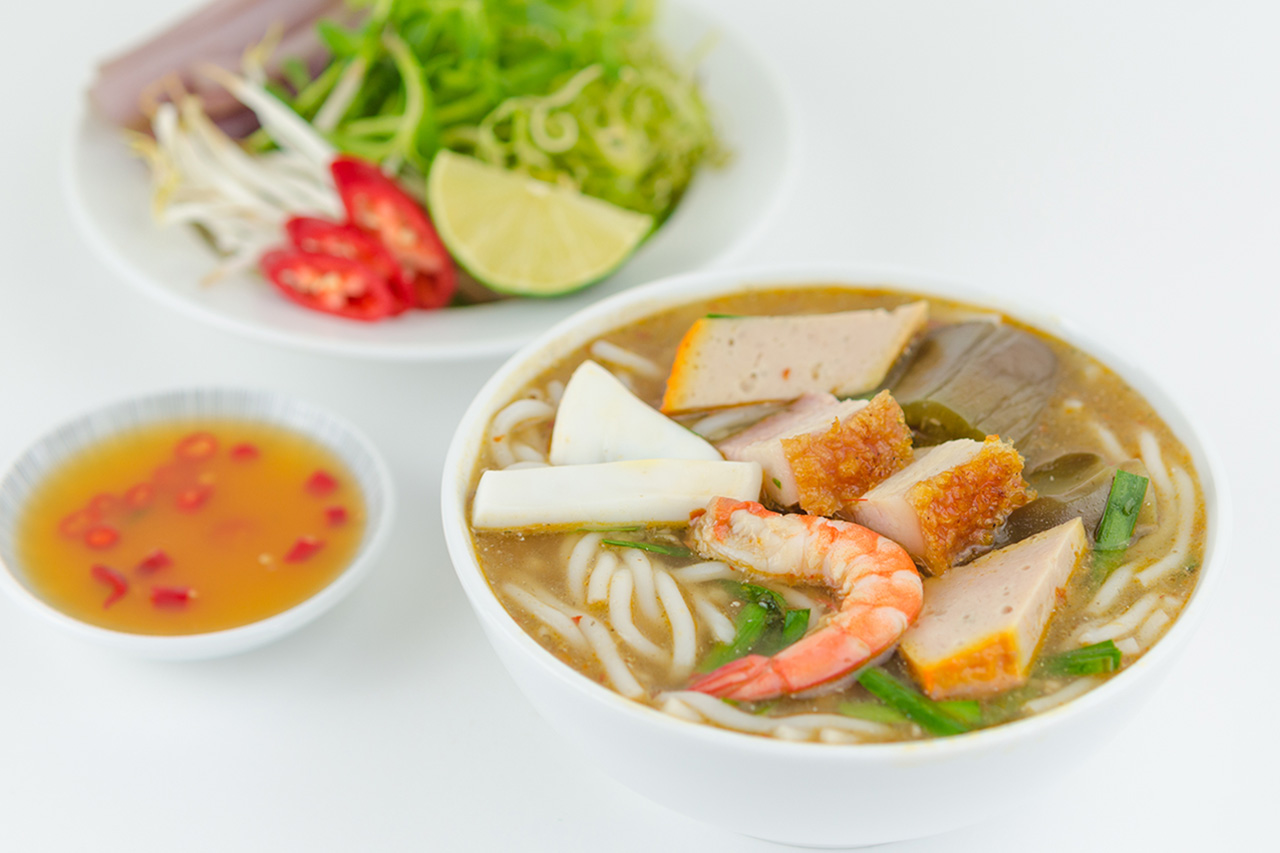Vietnam is full of unique local specialties, and over time, many of these dishes have traveled across the country and landed in different regions, just as bun cha Hanoi has become a favorite dish in Saigon while Saigon’s iconic com tam is now popular in the capital city. Yet there is one regional dish so distinctive in both its ingredients and its flavors that it is almost impossible to replicate outside of the Mekong region: bun mam. This fermented noodle soup is controversial, even among locals, but if you would like to deeply connect with the Mekong Delta of Vietnam, it is an essential culinary experience that cannot be missed. Let’s travel South and delve into the great complexity of bun mam.
What is bun mam?
To understand bun mam, we must, first of all, learn about mam itself. Mam is generally the product of the fermentation of fish or other types of seafood. Mam strongly reflects the geographic characteristics of the Mekong Delta – the southernmost region of Vietnam. The vast maze of rivers, swamps, and islands endowed by Mother Nature offers an abundance of freshwater seafood. This natural resource comes in such a large quantity and variety during the monsoon season, or oftentimes referred to as floating season, that people had to come up with innovative methods to preserve them for later use. Given the hot climate during this season, from August to November, there is no better way than fermentation to preserve the nutritious source of protein for dry months to come. The high temperature facilitates the process of fermentation, creating the delicacy that bears the heart and soul of the region.
Those who are exposed to Vietnamese cuisine may be aware of nuoc mam (fish sauce) and mam tom (fermented shrimp paste). However, when speaking of mam, people typically refer to fermented whole fish.
Fish is marinated with coarse salt and kept away from sunlight for 10 – 15 days. Once the salt has dissolved and soaked into the fish, the saltwater is filtered out, and the salted fish is mixed with thinh (roasted rice bran) and left in the shade for another two months. After the fish has absorbed the roasted rice bran, it is moved to a new jar and mixed with palm sugar, which is preheated into a liquid. This method allows the fish to be preserved and consumed for up to 12 months.
Back in the day, during dry seasons and severe droughts, mam was believed to be the main source of protein for many families. Mam has also contributed to the distinctive palate of the region: people often add lots of sugar to dishes to balance out the saltiness of mam. As a result, food from the Mekong region is especially intense, packed with sweetness and saltiness.
The origin of bun mam
Many documents point out that bun mam was an indigenous dish of the Khmer people in Cambodia. By the 12th century, the sea gradually receded, revealing fertile mounds that are now the Mekong Delta provinces of Soc Trang, Tra Vinh, An Giang, and others. These regions, which bordered Cambodia, attracted an influx of Khmer people. By the end of the 15th century, they had already established highly concentrated residential areas in southern Vietnam.
The original version of bun mam is made with prahok, the fermented fish featured in Cambodian cuisine. Prahok is extremely salty and pungent, as the fermentation process differs slightly from that of mam in Vietnam. When brought to the Southeastern provinces, prahok was replaced by fermented snakehead fish, Siamese mud carp, or three-spot gourami. These are common freshwater fish in the Mekong Delta, found in abundant supply during the flooding or floating season. By the mid-1970s, bun mam had migrated to Saigon, initially to ease the nostalgia of those moving away from home for work. Gradually, it gained popularity among city dwellers for its exotic taste and homely ingredients.

Bun mam ingredients
Bun mam is regarded as a signature dish of southern Vietnam, made from a unique blend of ingredients native to this water-rich region. Visually, a bowl of it resembles a miniature version of the lush Mekong Delta, showcasing the diverse bounty of the land and waterways in every bite. The four main components are the broth, noodles, toppings, and green veggies.
Broth
What makes bun mam stand out from other Vietnamese noodle dishes is the broth. Although bun mam’s broth does not require as much time to make as pho or bun bo Hue, its layers of flavors are much more complex. It is slightly pungent, salty, and murky, reminiscent of the color of the Mekong River water filled with fertile sediment.
To make the broth, fermented fish – preferably a mix of Siamese mud carp and gourami – is added to a pot of water and brought to a boil. It is cooked for 15 – 20 minutes on low heat, stirring constantly until the fermented fish is completely dissolved. The liquid is then strained to remove any remaining bones. At this stage, the base liquid is purely salty and pungent. It is the addition of condiments native to the Mekong region that brings out the spirit of the dish.
Ground lemongrass and shallots are sautéed until fragrant before the fermented fish liquid is added back to the mixture. This traditional method of cooking fish helps to abate the fishy smell.
Apart from lemongrass and shallots, a secret spice used in Southwestern-style fish noodle dishes is fingerroot. This plant, a member of the ginger family, is milder and more earthy. Not only does fingerroot give bun mam its distinctive flavor, but it also adds medicinal properties. According to Eastern beliefs, fermented fish is considered a cold food; hence, fingerroot, along with other condiments, provides heat to achieve a balanced yin and yang. To complete the umami taste, the broth is also enriched with pineapple or tamarind, which adds a subtle sourness. The whole mixture is brought to a boil again, completing the savory broth in roughly 30 minutes.
Noodles
Noodles are a main ingredient in Vietnamese cuisine. For bun mam, thick, round, and opaque rice noodles are used. They have a slightly chewy texture and do not stick together.
Toppings
A bowl of bun mam is lively and dynamic, just like its homeland. It might shock first-time diners due to the lack of consistency in its protein toppings. Typically, you will find squid, shrimp, and roasted belly pork, which is why bun mam is not strictly a seafood noodle dish.
I once asked some aunties in my village in the Mekong Delta about the curious presence of roasted pork in such a dish. What I was told was anecdotal but quite compelling: In the Mekong region, it’s common to roast a whole pig for large banquets. After the feast, there is always leftover roasted pork. Instead of discarding it, the people here get creative, adding it to other dishes like bun mam. It may sound odd to include meat in a predominantly seafood dish, but the flavors meld together in a surprisingly delightful way. Over time, crispy roast pork has become an essential ingredient, adding a savory crunch and richness to the already complex flavors of bun mam.
In Saigon, bun mam has become even more diverse due to the influence of cuisines from other parts of the country. Some restaurants add fried fish cake, chili and bittermelon stuffed with fish cakes, or boiled pork belly.
In general, the spirit of this Mekong-style noodle dish is that the possibilities are innumerable. Even though the toppings may be inconsistent or even random, they simply work when brought together.
Side veggies
Bun mam in Saigon typically comes with a platter of water lily stems, bean sprouts, shredded morning glory, banana blossoms, bitter herb, and fish mint. These can be served raw or blanched upon request. There are also lime wedges and fresh chili as table condiments that you can add to your dish. However, if you have a chance to take a Mekong trip, you’re likely to encounter a greater variety of side vegetables paired with bun mam, which we will discuss in more detail later.

Variations of bun mam
Let’s travel back to the South. Bun mam has several regional variations and adaptations across Southern Vietnam. Each of these varieties stays true to the signature salty and pungent flavors of fermented fish, but the toppings and preparation methods vary depending on regional cultural and natural conditions.
Lau mam Ca Mau
Lau mam, or fermented fish hotpot, is essentially an extended version of bun mam. This is a specialty of U Minh, Ca Mau – the southernmost province of Vietnam’s inland territory. The wetlands around U Minh National Park provide ideal habitats for many aquatic plants and native vegetables, especially edible flowers and weeds.
If a platter of vegetables for bun mam feels like a botanical garden, the one for lau mam is as lush as U Minh National Park itself. It fully encapsulates the flavor of the countryside and the wilderness of the land. The vegetables include the crunchiness of bean sprouts, morning glory, winged bean (or four-angled bean), and water lily stems; the sweetness of eggplant and mushrooms; the bitterness of brahmi (or water hyssop), fiddlehead fern, and green mustard; and the magnificent fragrance of water lily flowers, vegetable hummingbird, and water mimosa (yes, they are all edible). These are just a few examples – in reality, the list could include 15 to 20 types of vegetables.
The toppings also come in a wider range, typically whatever people can find in nature around their homes: catfish, eel, crab, etc. The broth is watered down to ensure it doesn’t become too salty while being served on a gas stove.
This hotpot is an iconic communal dish, perfect for large groups. Diners can dip their favorite vegetables into the bubbling, aromatic broth while sharing rice wine and enjoying the company of friends and family.
Bun ca Chau Doc
Bun ca in Chau Doc is probably the closest to its Cambodian version, given that Chau Doc borders Cambodia. The key difference between bun ca and bun mam is that the main topping for the former is freshwater snakehead fish fillets. It is traditionally served with Vietnamese coriander and water mimosa, which sets it apart from the vegetable collection of bun mam.
One more thing that distinguishes bun ca Chau Doc from bun mam is the tangy dipping sauce, which is fish sauce mixed with tamarind. This unique combination of tamarind fish sauce is a signature in the Mekong, often paired with dishes featuring snakehead fish.
Bun nuoc leo Soc Trang
Soc Trang is the Mekong Delta province with the largest population of Khmer ethnicity. In terms of color and flavor, bun nuoc leo and bun mam are quite similar. The subtle difference is that the broth of bun nuoc leo is clearer because the lemongrass and shallot are only roughly smashed, rather than ground. Additionally, the rice vermicelli used in bun nuoc leo is slightly smaller than that of bun mam.
Vegetarian bun mam
A vegetarian-friendly version of bun mam replaces meat with tofu, vegetarian patties, and several types of mushrooms. The fermented fish alternative is made by blending fermented bean paste and white bean curd. This mixture has the signature pungent taste, which closely resembles its savory counterpart.
Bun Mam of the Mekong Delta vs. Bun Mam of Central Vietnam
These two dishes are often confused due to their similar names, but they are entirely different in almost every aspect. The only common denominator is the use of fermented fish as a core ingredient.
In Central Vietnam, bun mam is actually called bun mam nem, though the locals often shorten the name for convenience, and it has gradually become simply bun mam. This version is a dry noodle dish made with rice vermicelli and topped with a variety of fresh herbs and vegetables, such as lettuce, cucumber, bean sprouts, Thai basil, mint, and perilla. Additionally, in this region, bun mam is paired only with boiled pork belly or, occasionally, pork ears, unlike the diverse array of protein toppings found in the Southern version.
To serve, a mixture of fermented fish – typically anchovy – is poured over the noodles. This fermented anchovy paste is pre-seasoned with garlic, chili, and other common spices. The diners then give it a good mix and enjoy. Visually, bun mam in Central Vietnam resembles a noodle salad rather than a noodle soup, as is the case with bun mam in the Mekong Delta.

When to eat bun mam
Needless to say, bun mam is best savored on rainy days, reminiscent of the monsoon season in the Mekong Delta. From an Eastern medical perspective, bun mam is categorized as having “hot” properties that provide warmth on a chilly day.
However, don’t hesitate to try it if you visit Vietnam during the dry season, as bun mam is a hearty lunch and dinner choice enjoyed by locals year-round. While you can find bun mam served throughout the day at various eateries, it might be too bold for breakfast, especially if you plan to enjoy a glass of Vietnamese ca phe sua da to kickstart your day – since both are hot foods that may leave you feeling heavy. Lunchtime is, in my opinion, the best time to enjoy bun mam. A savory, filling bowl of bun mam is perfect for satisfying your lunch cravings.
Tips to enjoy bun mam
- All the ingredients of bun mam are typically displayed in a glass cabinet. You can check through the glass to make sure you’re happy with the options. If not, feel free to point out the ingredients you’d prefer, and the owner will customize it for you.
- You can request the owner to blanch the veggies for better hygiene, but don’t skip this step – besides the savory broth, the veggies are the highlight of the dish.
- Don’t expect to become a fan of bun mam after just one try. Its rich complexity can be overwhelming at first, and it may take a few attempts to overcome the pungent aroma. Once you do, however, you’ll find this unique culinary experience incredibly rewarding.
- Drink plenty of water after eating bun mam to help balance out the excess salt in the broth.
Where to eat bun mam
Bun mam is not a dish for the faint of heart. Its bold, pungent flavors may take some time to get used to, but it’s well worth trying if you’re a food enthusiast or an adventurous explorer. As a culinary ambassador of the Mekong Delta, it not only represents the heart of local cuisine but also showcases the boundless creativity of its people. We hope you have the chance to try it and share your impression of this authentic dish. Here are some recommended restaurants where you can enjoy bun mam:
Ho Chi Minh City
- Co Bong
Address: Tan Dinh Market, Tan Dinh Ward, District 1
Price: 60,000 VND ($2.4) - Bun Mam 144
Address: 144 Khanh Hoi, Ward 6, District 4
Price: 75,000 VND
Can Tho
- Bun Mam 173
Address: 594 30/4 Street, Hung Loi Ward, Ninh Kieu District
Price: 47,000 VND - Bun Mam 25
Address: 25 Truong Dinh, Tan An Ward, Ninh Kieu District
Price: 30,000 VND


